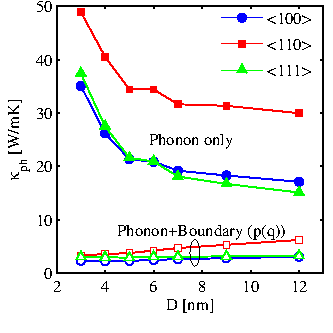
|

|
The thermal conductivity of silicon nanowires versus diameter is shown in Fig. 6.1 for nanowires
in the
![]() (blue lines),
(blue lines),
![]() (red lines), and
(red lines), and
![]() (green lines) transport orientations. With solid symbols we show the phonon-phonon scattering-limited thermal conductivity, whereas with empty symbols the thermal conductivity additionally includes phonon-boundary scattering. Several interesting observations can be made here. First, there is a significant anisotropy in the thermal conductivity, with the
(green lines) transport orientations. With solid symbols we show the phonon-phonon scattering-limited thermal conductivity, whereas with empty symbols the thermal conductivity additionally includes phonon-boundary scattering. Several interesting observations can be made here. First, there is a significant anisotropy in the thermal conductivity, with the
![]() nanowires having the highest conductivities in the entire diameter range, also in agreement with other theoretical studies [111]. Second, the phonon-phonon scattering-limited thermal conductivity
(solid symbols) is reduced by a factor of
nanowires having the highest conductivities in the entire diameter range, also in agreement with other theoretical studies [111]. Second, the phonon-phonon scattering-limited thermal conductivity
(solid symbols) is reduced by a factor of
![]() from to the bulk value which is
from to the bulk value which is
![]() . This indicates the strong influence of phonon confinement. Third, phonon-boundary scattering has a quite strong influence, reducing the thermal conductivity by another factor of
. This indicates the strong influence of phonon confinement. Third, phonon-boundary scattering has a quite strong influence, reducing the thermal conductivity by another factor of
![]() , limiting the thermal conductivity to values below
, limiting the thermal conductivity to values below
![]() in the entire diameter range, irrespective of transport orientation.
in the entire diameter range, irrespective of transport orientation.
This strong reduction of the thermal conductivity is the main reason for the
improved thermoelectric performance in nanostructures. Phonon-boundary scattering is
the main reason for that reduction, although phonon confinement also contributes to
![]() reduction. For nanowires with ultra-narrow diameters, however, the electrical conductivity is also strongly degraded by SRS, and it is yet not clear if rough boundaries can still provide a benefit to the
reduction. For nanowires with ultra-narrow diameters, however, the electrical conductivity is also strongly degraded by SRS, and it is yet not clear if rough boundaries can still provide a benefit to the ![]() . Below, we provide answers to this issue.
. Below, we provide answers to this issue.